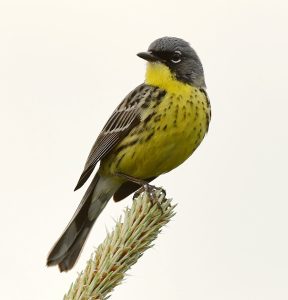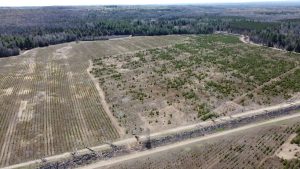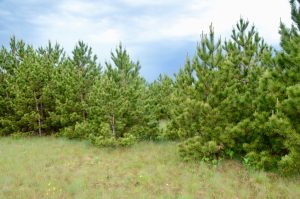By Peter Burke
In June 2022 the endangered Kirtland’s Warbler found a new home in southern Ontario, Canada. This is a significant milestone. Successfully creating habitat for a severely at-risk species is a tremendous environmental achievement.

There are fewer than 5,500 Kirtland’s Warblers in the world. The warbler is a lemon yellow and pastel blue sparrow-sized bird that breeds only in young pine and oak forests that regenerate after large-scale disturbances, such as fires, in the Great Lakes region of the U.S. and Canada. It was one of the first species to be listed by the U.S. Endangered Species Act in 1973 and given the status of Endangered in Canada in 1979.
I began working on the recovery of this species in Canada in 2013 with surveying for Kirtland’s Warblers in vast Jack Pine stands of Ontario north of Lake Huron. Failing to find any there, we surmised that the target area needed to shift southwards, to Ontario latitudes equivalent to the bird’s stronghold in the northern Lower Peninsula of Michigan.
Using GIS tools to identify suitable matching soils with Michigan breeding sites, we centered our attention on key areas of southern Ontario with dry sands and pine-oak communities. To our disappointment, we discovered that no suitable habitat existed for the species, mainly due to the conversion to human uses and lack of natural disturbance (i.e. fires) that create the bird’s vegetation community. It seemed that there was not much hope of finding new breeding areas for Kirtland’s Warbler in Ontario given the current and foreseeable state of the focal area.
Habitat team forms

The next step was to try and create the Kirtland’s habitat where it once occurred in this region of Ontario. The County of Simcoe’s forestry department was our first choice as a partner since the County had historical evidence of the warbler breeding. This organization had a strong program and indicated that they were willing to help. This led to the 2017 formation of a team of ecologists, restoration experts, and forestry professionals at the municipal, provincial, and international level. Together, we strategized to restore 128 acres of a former railway activity pit, now owned by the county, called the Museum Tract.
Additional funding to assist the County of Simcoe came from the Federal Habitat Stewardship Program, Trees Ontario, American Forests, as well as the First Nations of Henvey Inlet on Georgian Bay (Ganawenim Meskiki). This funding support enabled us to start habitat restoration at a second county-owned site, called the Packard Tract, in 2019. Our team restored both sites through extensive site preparations (including tree removals and prescribed burning), collection, and seeding of 90 species of native plants known to be associated with young pine-oak woodlands. Jack and Red Pine seedlings were planted at densities known to be preferred by the warbler. The restorations strove to attract the warblers, but also to achieve restorative, scientific, recreational and cultural objectives that are signposts of a successful design in putting significant funding into a program such as this.
The decision to create habitat was based on the idea that Kirtland’s Warblers would be able to locate that habitat. For such a small bird to find these restored lands seemed like a longshot, but we had some recent science to back up our assumption. Dr. Nathan Cooper of the Smithsonian Institution had demonstrated that some Kirtland’s Warblers were moving around southern Ontario during the breeding season. Dr. Cooper determined this by using a tracking device called a geolocator (part of the MOTUS Wildlife Tracking System program) attached to the birds’ backs.
The moment of truth
How long would it take for the Kirtland’s to find a parcel of good habitat? The answer seemed like anyone’s guess, but we felt that our choice of location improved our chances substantially.
The only thing we could do at that point was to wait and see if our efforts paid off. Would this rare bird find these restored lands?

On May 31, 2022, local birder Jim Forrest reported two Kirtland’s Warblers at the Packard Tract and photographed them. On June 8, Willem Span of the Nottawasaga Valley Conservation Authority contacted us to say he had heard Kirtland’s at Packard. This was the first news we received of a bird at either of our sites, but we were cautious. We didn’t want to celebrate before we could confirm the sightings. The restoration team convened at Packard on June 9 and found that no fewer than four males were present! Our elation and shock that day was a defining moment for the project. We had successfully created habitat for a bird with fewer than 5,500 individuals remaining, and over 500 miles from the main population source in Michigan. The birds themselves had found it – and more than just one!
The author Ray Kinsella famously wrote: “If you build it, they will come.” This can happen even when conserving rare species. Together, the team created the structural and specific vegetation components to attract these rare birds. It is not a common occurrence to create habitat so successfully for such a rare organism, and GEI stands out for helping to accomplish this remarkable achievement. The effectiveness of local, seed-based restoration and the benefits to the entire community of plants and animals that use this early successional pine-oak forest of the Great Lakes basin will make this work even more celebratory in the years to come as more sites are created.
Contact me, Peter Burke, to learn more about this project and how we can help with creating habitat for species beginning with early succession in terrestrial systems.